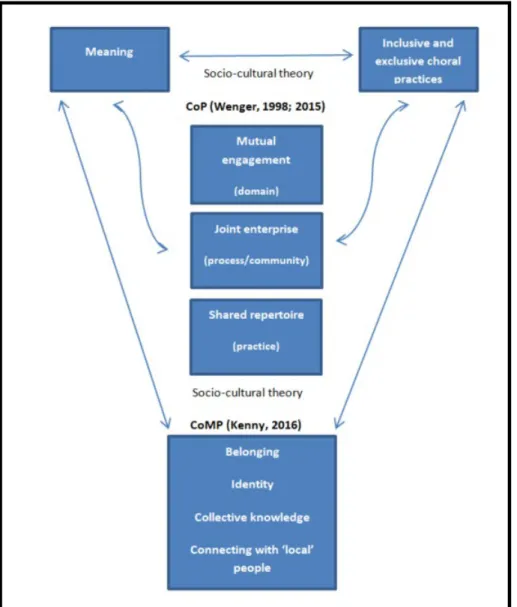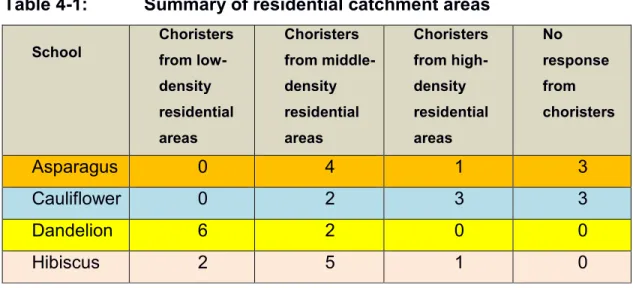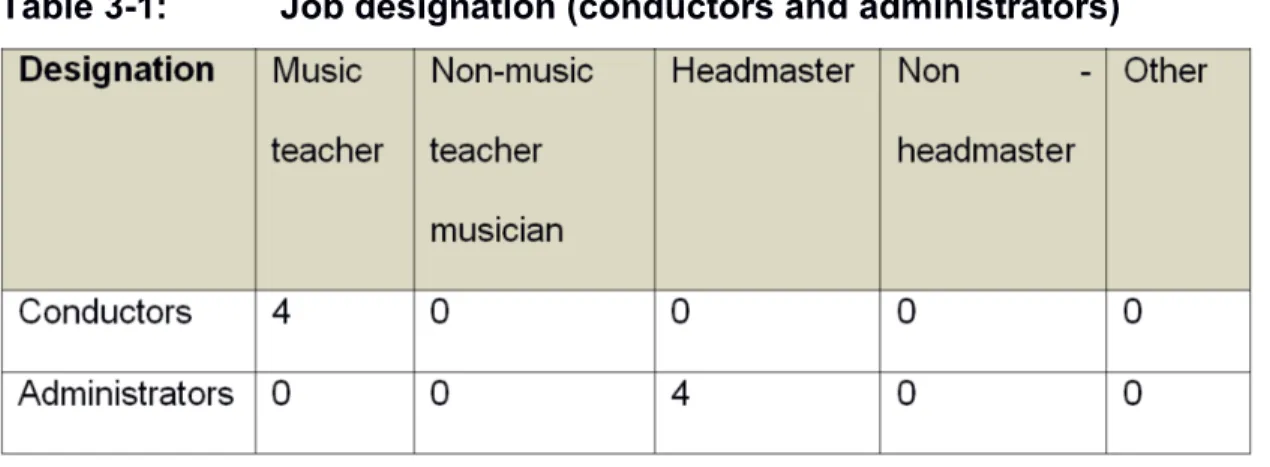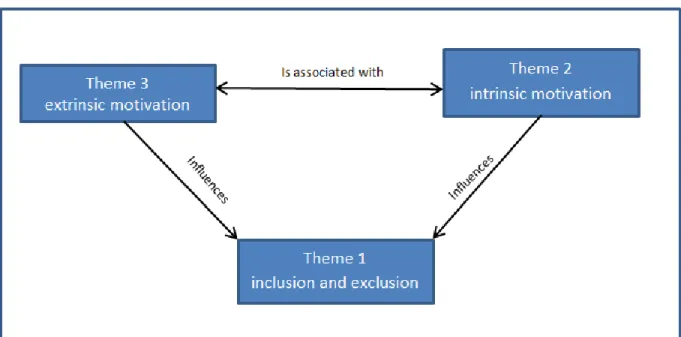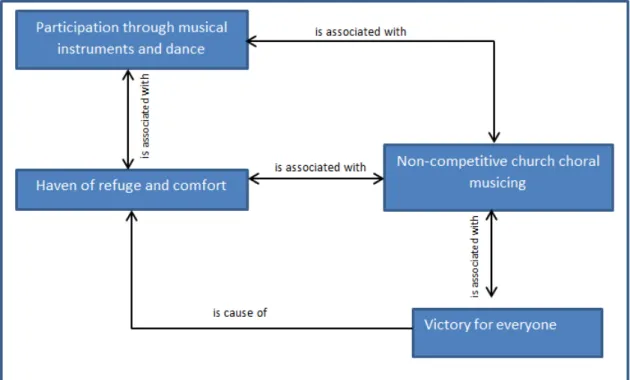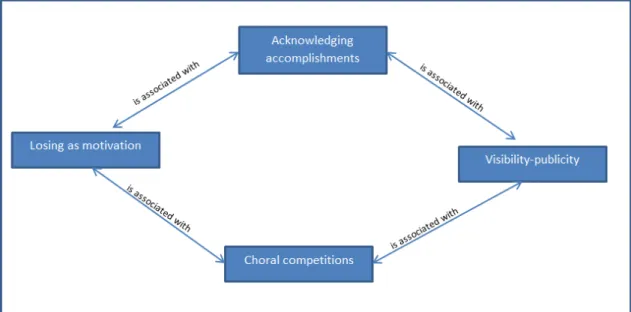Extrinsic motivation was discussed in the following categories: achievement recognition, visibility and publicity, losses as extrinsic motivation, and choral competitions. This topic is of great importance to music education and choral practice in general, as its findings will shape the decisions choral music teachers make.
Introduction
- A vignette of musical experience
- Inclusivity and exclusivity
- Use and function
- Two key theoretical concepts
- Purpose statement
- Central research question
- Research design
- Sampling
- Data collection (see Chapter 4.5 for detailed discussion)
- Data analysis (see Chapter 4.6 for detailed discussion)
- Ethics (chapter 4.8 for detailed discussion)
- Researching children’s experiences: Specific ethical considerations
- The involvement of children
- Informed consent
- Conclusion
The recruitment procedure (see also Chapter 4.2 for details) was as follows: .. i) Participants were selected by the researcher using purposive sampling and all participants were given verbal and written information about the aims of the research and an opportunity to ask for clarification if they did not understand. In the unlikely event that the participant became bored or anxious in the interview, I arranged for assistance from the school counselor.
Literature review
Introduction
Philosophy of music education in context
- Beginnings: Utilitarian music education philosophy
- Aesthetic music education philosophy
- Praxial music education philosophy
- Artistic citizenship as an agent of social capital in praxial music education
- Current pragmatic conversations and postmodernist philosophizing on music
- Care ethics in music education
4 Some dualisms common in the history of music education (both in philosophy and advocacy) include issues such as aesthetic education versus praxial education; performance versus pedagogy; competition versus non-competition; teacher-centered (apprenticeship) versus learner-centered learning; traditional (western) versus contemporary pedagogical approaches and many others. Aesthetic philosophy became the prevailing and preferred philosophy of music education in much of the Western world.
Social capital in music education
Both of the above perceptions of social capital are consistent with the way music, education and music education have been conceptualized in the past. Perst argues that this similarity arises because the nature of music, teaching and music education has the inherent potential to produce effective social capital.
Musical meaning
All these studies emphasize that people's perceptions and experiences in musical group interaction are determined by the intrapersonal and interpersonal social context, all of which point to the importance of social capital. Artistic citizens are committed to the practical ideal of "making art work" in ways that can bring people together, alleviate social problems, increase social well-being, and contribute significantly to achieving a better quality of life.
Meanings of choir music practice in context
In light of the importance of artistic citizenship in music education and all the social goods it promotes, it is necessary to examine the relationship between inclusiveness and exclusiveness as two points on a continuum in choral music practice and community. the technical and compositional qualities of the music formed the basis of the music's meaning and aesthetics (Lerdahl's sociological and anthropological embedding is the basis of understanding musical meaning;
Inclusivity and exclusivity as poles of a continuum
- Inclusivity and exclusivity in choral practice
- Musical elitism and exclusion
While such a song is inclusive of the downtrodden, it also excludes a portion of the people considered to be on. The Choir's activities are designed to address all of these, albeit with some difficulty.
Conclusion
This model focuses on the few "talented" individuals who have means and access to such training and achievement. There are many exclusionary tendencies inherent in this model which is considered to be based on "talent", such as admission by audition (eg elite music schools such as Julliard, Berklee and Eastman in the United States).
Communities of practice (CoP) theoretical framework
Discussion of the “CoP” theoretical framework
The use of the CoP and, in particular, the CoMP, as the theoretical basis for this study is made on the premise that they also include some essential socio-cultural theories (Vygotsky, 1978; Rieber & Carton, 1993). It is also on the premise that CoP and CoMP theories also cover Bourdieu's work, which essentially suggests that CoMPs are situated within social contexts.
Communities of Musical Practice (CoMP)
- Social identity and sense of belonging
- Musical style communities and stylistic diversity
Teachers' musical identities are shaped by their relationships and experiences (Hargreaves & Marshall, 2003:263). Essentially, optimal experiences (including well-being, flow, happiness, positive emotions, engagement, relationships, meaning, and achievement) are to some extent the result of active engagement and expansion of self-other relationships that build an individual's identity (Croom Hargreaves et al. Welch et al.
Conclusion
As indicated above, relevant to the discussion of music genres as communities of music practice is the appeal of Bowman (2007a:1) and Elliott, who urge music teachers to embrace a pluralistic multicultural approach. Contemporary music education should therefore embody this diversity by embodying all styles of music making and consumption as unique communities of music practice (Elliott & Silverman Veblen, 2005: 314).
Research procedures
- Introduction
- Qualitative research approach
- Philosophical assumptions
- Research design
- COVID-19 pandemic implications on cases
- My role as a researcher
- Data-collection procedures
- Data analysis
- ATLAS.ti 9
- Ethics
- Validation
- Conclusion
This was after unforeseen closures earlier this year due to the escalating number of people testing positive for COVID-19 in Zambia and the sub-region. There was continuous monitoring by the researcher and ethics committee from NWU of the ethical standards throughout the research to ensure that there was no deviation from the approved status. In the process, the themes provide assertions and interpretations of the rich texture of the data.
I also explained the process of data analysis and thesis report writing, and emphasized the reliability of findings and ethical considerations throughout the study.

Findings (Data description)
Introduction
Main themes
I researched how motivation, as the most important theme of my data, affects inclusion and exclusion in choral practice.
Theme 1: Inclusion and exclusion
- Inclusion and inclusivity
- Exclusion and exclusivity
I consciously let them be part of the group until they really feel they belong.” Much of the challenge has to do with space; we do not have a dedicated choir or music room. Similar feelings exist with Mr. Besa, who told me that he just couldn't turn away a chorister because of the pressure of auditioning for any activity.
The educational goals of the school and their personal philosophy guide decisions to include or exclude for these music teachers and choral conductors.
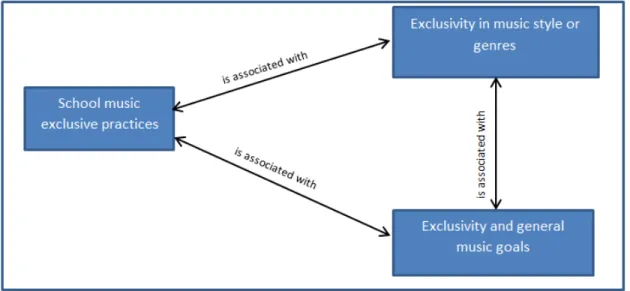
Theme 2: Intrinsic motivation
Similar reasons were given by 2cents who told me that "my friend was the one who introduced me to the choir". Nalu enthused that “I learned how to play the traditional drums while I was a member of the choir. Mrs. Nana noted that “as time went by, many choristers learned to read sheet music because of being in the choir.
Mrs. Nernel noted that “being in choir is of great value because students learn many skills during school.
Theme 3: Extrinsic motivation
Mr Roberts commented that “participating in these things helps us put our school on the map; they will know that there are Hibiscus out there that are the champion corals. Director of Asparagus, Mr. Phiri, also commented and said that "every discouragement should make a teacher and student get up and do better next time". Mr. Hamu told me that “for competitions, we usually choose the crème de la crème62 to represent the schools.
However, Eagle told me that "even though it's okay to celebrate and feel good about winning, when you win, you have to be humble".
Conclusion
Discussion (data interpretation)
Introduction
Significant findings and interpretations
Theme 1: Inclusion and exclusion
With the influence that the church has on forming musical identity, I recommend further research into how the church in Zambia provides musical experiences. This is in line with previous research, especially on the state of music education in some African countries (Detterbeck Nzimande. In their study, Mubita et al. concluded that many music programs closed down due to lack of resources and the nature of priorities: music and art is usually at the bottom of the list.
This despite the attempts made through continued advocacy to promote music education and the arts.
Theme 2: Intrinsic motivation
119 In intrinsic motivation, as seen by many of the participants' responses, the sense of competence, a sense of relatedness to others and autonomous motivation (elements of SDT) are fundamental reasons for participating in music making. My finding is that the non-competitive, .. 120 community-centered festivals and activities seemed to resonate with the majority of choir members and provided an experience of "flow." Above all, however, participants emphasize the importance of the sense of belonging which is very closely related to relatedness as described in SDT (Ryan & Deci.
As already mentioned, in a typical community model, interpersonal musical practices (Higgins Pohly and intrapersonal experiences) are key to the functioning and meaningful participation of school choir members as participants in an artistic community (Veblen & Olsson.
Theme 3: Extrinsic motivation
Competitions
Policy and practise implications
This is especially true of skill-based auditions and the purpose of choral competitions such as NASAAZ. My data points to the need to strengthen progressive and meaningful music practices and to address contentious issues such as "talentedness," skill-based auditions, and other exclusive practices. Teachers should adopt methods that ethically enable choristers to experience the "good" and eudaimonic potential (Elliott) inherent in choral singing and other ways of making music.
Choristers are usually already intrinsically motivated, and the choral environment should support and develop their well-being and allow them to experience eudaimonia.
Proposed model
- Self-determination theory
- Contextualising theory and data
- Model description
The three psychological needs that must be met in autonomous motivation are competence, autonomy, and relatedness. The three main themes that emerged from the data are inclusion and exclusion, which include both autonomous motivation (intrinsic motivation) and controlled motivation (extrinsic motivation). As can be seen from the various activities described by the participants69, the activities in choral practice are influenced by both autonomous (internal) and controlled (external) motivation.
The last level of the diagram shows what I propose as a model of choral practice based on autonomous motivation.
Limitations of the study and recommendations for future research
Extrinsic motivation (controlled motivation) includes aspects of competence and relatedness, but autonomy is completely absent.
Conclusion
Postlude: Why am I not good enough?
Approaches to qualitative research: The Oxford handbook of qualitative research in American music education: Vol. 1. International Association for Music Education Commission on Music in Cultural, Educational and Mass Media Policies (ISME 2012). Proceedings of the International Society for Music Education (ISME) 2008 Commission on Community Music Activity Seminar.
Interview protocol
How would you feel if for some reason you would not be able to participate in choir singing. What things would you like to see different in Zambian secondary school choral music? In your opinion, what is the role of choral competitions and festivals in secondary schools in Zambia.
What are some of your expectations and wishes for your school choir as a school administrator, in the short and long term?
Permission letters and consent documents
Title of the study: The significance of inclusive and exclusive choral practices in selected junior secondary schools in Zambia. No risk x Motivate: The children will not be exposed to any other risk than they encounter in normal daily life.
